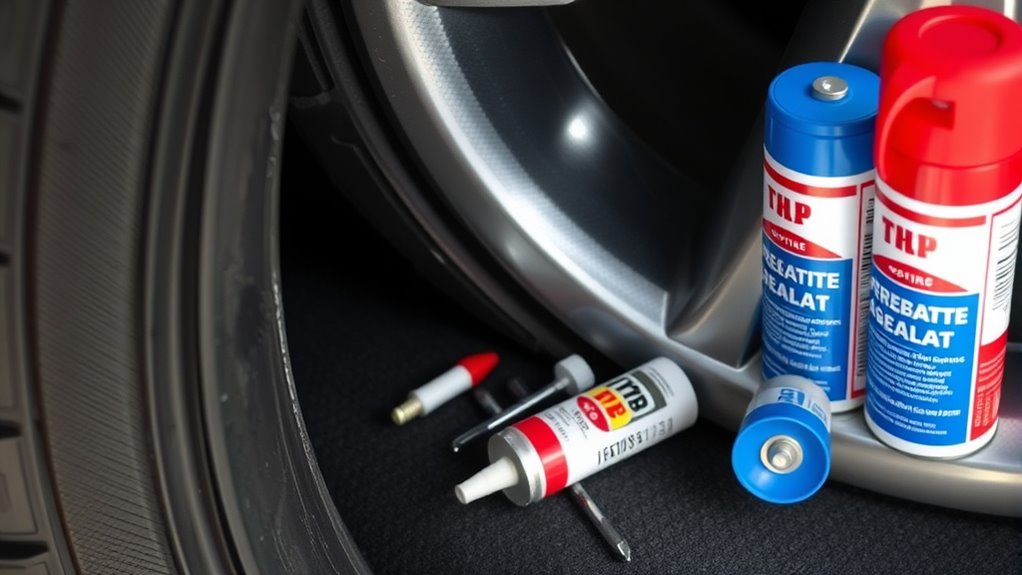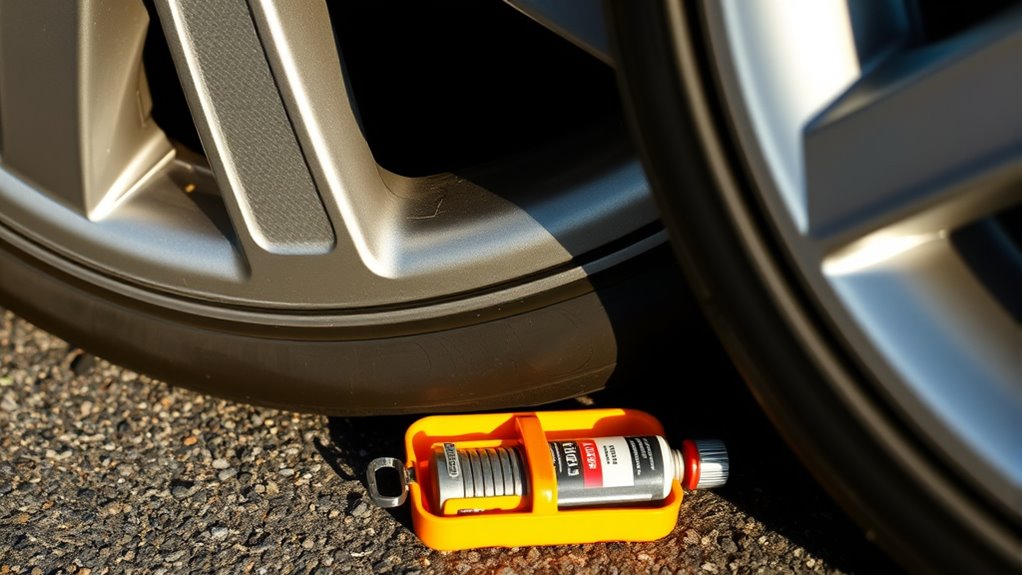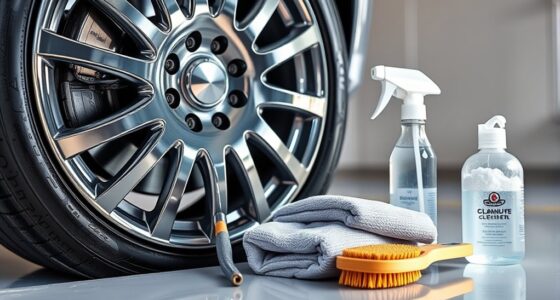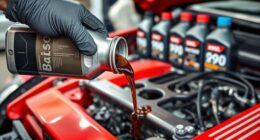Tire sealants and emergency repair kits are handy for quick fixes during unexpected flat tires, especially if the puncture is small and within the product’s specified size range. Use them to temporarily seal punctures in the tread area and get you to safety or a repair shop. They’re not meant for large cuts or sidewall damage. For best results and to stay prepared, you’ll discover more about when and how to use them effectively.
Key Takeaways
- Use tire sealants for small punctures in the tread area to quickly restore air pressure during emergencies.
- Emergency repair kits are suitable for temporary fixes when professional repairs are unavailable.
- Sealants are not recommended for large cuts, sidewall damage, or beyond their specified size limits.
- Properly select sealants compatible with your tire type (tubeless, tubed, run-flat) for effective sealing.
- Always follow manufacturer guidelines and inspect tires regularly to prevent punctures and determine appropriate repair methods.

When a flat tire strikes unexpectedly, having tire sealants or emergency repair kits on hand can be a game-changer. These tools offer a quick fix that can get you back on the road without waiting for roadside assistance. But to maximize their effectiveness, you need to understand when and how to use them properly. One key aspect is puncture prevention. Using sealants that are compatible with your tire type ensures you’re not just patching a temporary hole, but also reducing the risk of future punctures. Sealant compatibility matters because different products work best with specific tire types—be they tubeless, tubed, or run-flat tires. If you choose a sealant that isn’t compatible with your tires, it could cause damage or fail to seal properly, leaving you stranded again. Before buying or using a sealant, check the manufacturer’s recommendations to confirm compatibility with your tire model and size.
When a puncture occurs, you might feel or hear a sudden loss of pressure, which signals the need for immediate action. In such cases, a tire sealant can be your best friend. It works by quickly sealing small punctures in the tread area, allowing you to continue driving safely for short distances. Sealants are especially effective for punctures caused by nails, screws, or thorns, as long as they are within the size limits specified by the product. Keep in mind that sealants aren’t a universal fix—large cuts or sidewall damage usually require professional repair or replacement. Using a sealant that’s compatible with your tires ensures a proper seal, preventing air from escaping and reducing the risk of a blowout. Additionally, understanding the difference between sealants and repair kits can help you choose the right tool for your needs.
However, it’s not just about using a sealant in emergencies. Puncture prevention is equally important. Regularly inspecting your tires for embedded debris or signs of wear can help you avoid unexpected flat tires. Proper tire maintenance, including correct inflation and avoiding overloading, minimizes the chances of punctures happening in the first place. When you’re prepared with the right sealant, knowing its compatibility with your tire type, you’re better equipped to handle sudden punctures swiftly. This means less time stranded on the side of the road and more confidence in your vehicle’s ability to handle minor mishaps. Ultimately, understanding how to choose the right sealant and maintaining your tires can save you money, time, and stress when the unexpected happens.
Frequently Asked Questions
Can Tire Sealants Damage My Wheel or Tire?
Tire sealants can cause wheel damage if used improperly or if they react with your wheel’s material. Sealant limitations include potential clogging or imbalance, which might lead to further issues. You should only use sealants for temporary fixes and avoid prolonged use, especially on high-performance or alloy wheels. Always follow manufacturer instructions, and get your tire inspected by a professional to prevent long-term damage.
Are Emergency Repair Kits Suitable for All Tire Types?
Think of emergency repair kits as a Swiss Army knife for your tires—they’re handy but not a one-size-fits-all solution. They’re generally suitable for many tire types, but compatibility concerns and sealant limitations can trip you up. Some kits work best on tubeless tires, while others might struggle with certain sidewalls or damaged internal structures. Always check your tire’s specifications before relying on a repair kit, so you’re not caught flat-footed.
How Long Can I Drive After Using a Sealant?
You can usually drive about 100 miles after using a sealant, but it depends on your tire pressure monitoring system and sealant compatibility. Check your tire pressure regularly, as sealants can affect sensor readings. Make sure the sealant is compatible with your tire type, and follow the manufacturer’s guidelines. It’s best to get a professional inspection soon after utilizing a sealant to ensure safety and proper tire function.
Do Sealants Work on Sidewall Punctures?
Sealants generally don’t work well on sidewall punctures because of limited sidewall durability and reduced sealant effectiveness in that area. The sidewall flexes more, making it harder for the sealant to form a reliable, lasting seal. If you get a sidewall puncture, it’s best to replace the tire promptly, as relying on sealants may compromise safety and performance. Always inspect the area to determine the best repair option.
Can I Use a Repair Kit on a Tire With Multiple Punctures?
Did you know that over 60% of roadside tire repairs involve multiple punctures? You can attempt a repair kit on a tire with multiple punctures, but it’s often not reliable. Repair kit limitations mean they may only seal one or two punctures effectively. For multiple punctures, especially in the sidewall or more significant damage, replacing the tire is the safest, most dependable option.
Conclusion
Remember, tire sealants and emergency repair kits are your trusty sidekicks when trouble strikes, like a superhero’s secret weapon in your glove box. Use them wisely—only when a quick fix is needed and a professional repair isn’t immediately available. Think of them as a safety net, catching you before a small leak turns into a roadside ordeal. So stay prepared, stay safe, and let these tools be your silent guardian on every journey.









